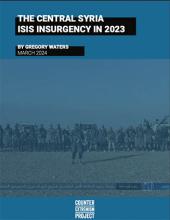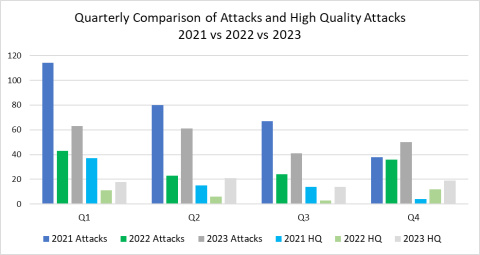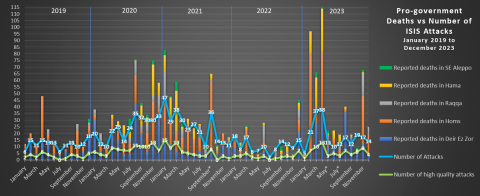Key Facts

-
In 2023, ISIS killed more than 285 soldiers and 231 Civilians, and wounded more than 212, in the Homs, Hama, Raqqa, Aleppo, and Deir Ez Zor governorates of central Syria. This amounts to a 195 percent increase in military deaths and a 745 percent increase in civilian deaths compared to 2022.
-
Of the 231 murdered civilians, 206 civilians were killed during the truffle season between February and April. During this period, ISIS killed an unprecedented number of civilians and security forces since its insurgency began in 2018.
-
ISIS militants conducted at least 215 attacks in 2023, 168 percent of the total in 2022.
-
Of the 215 documented attacks in 2023, 72, or 33 percent, were high quality attacks. Both a quantity and percentage increased in 2023 compared with 2022 and 2021.
-
ISIS conducted multiple IED attacks inside the cities of Damascus and Homs.
-
ISIS militants conducted four distinct offensives during 2023, the last of which continues into 2024.
Executive Summary
The year 2022 marked a low point for ISIS’s central Syria insurgency. It was recovering from sustained Syrian regime and allied Russian and Iranian operations in 2021 and appeared to focus its resources on northeast Syria. However, 2022 ended with a minor but clear uptick in aggressiveness, as ISIS militants captured the critical village of al-Kawm, straddling the Sukhnah-Raqqa highway in the Homs governorate. This shift in posture continued and expanded into 2023. This year witnessed a dramatic increase in ISIS attacks, high quality attacks, and civilian and military casualties. Aside from the quantitative increases, ISIS attacks also took on a much more aggressive and confident nature. The group gradually re-adopted attack styles it had not used since 2020 such as fake checkpoints, highway ambushes, and capturing regime positions.
This year saw three key developments in central Syria, all of which could impact the group’s activities in both central and northeast Syria in 2024: 1) The withdrawal of Russia’s Wagner PMC from central Syria in September 2023, replaced by Iranian-backed Syrian and foreign forces; 2) the return of ISIS improvised explosive device (IED) attacks inside the cities of Damascus (4) and Homs (2); and 3) the overall increase in ISIS activity.

January 2023 was the second calmest month on record since the ISIS insurgency began in late 2018. However, February marked the start of the truffle hunting season—an important seasonal economic activity for locals in the Badia—and with it, ISIS cells exploded onto the scene, targeting groups of civilians and their security escorts across central Syria. Between February and April, ISIS cells killed more than 200 civilians and 80 security forces. This activity was concentrated in the eastern Homs desert south of Palmyra and Sukhnah, west Deir Ez Zor around Jabal Bishri, and in eastern Hama. East Hama, which had been a key theatre for ISIS in 2020, had long gone dormant. Regime operations in the area appeared to have ended kinetic ISIS activity for much of 2021 and nearly all of 2022. Violent incidents in the governorate during this time were confined to mines or IEDs, which mostly impacted civilian shepherds. But the start of truffle season in 2023 saw a swath of small arms attacks against locals in the governorate as ISIS cells either reactivated or pushed back into the province. Small arms attacks and mine/IED activity continued at an elevated level into the early fall.
ISIS’s second offensive of 2023 was a continuation of its battles around al-Kawm, which the regime and allied Russian Wagner forces had recaptured in December 2022. Between March and April, ISIS cells engaged in nearly daily clashes on three flanks of al-Kawm. Wagner-led Syrian forces attempted to create a defensive perimeter around the village, but ISIS was ultimately able to hold the mountains and force a stalemate in the plains below. While this offensive’ was more of a defensive operation, it marked the first serious sign that a major change had taken place within the Badia. ISIS cells had, since early 2021, adopted an extremely cautious, risk-avoidance approach to its attacks. Cells focused more on long-range harassments, mining patrol routes, and the occasional hit-and-run small arms attack. Now, the group was willing to remain in place and fight essentially a pitched battle for the first time in more than two years.
The third distinct offensive of the year began in August in southern Raqqa and western Deir Ez Zor. ISIS militants had slowly increased their activity in the area since June, likely redeploying some of the cells that had been ambushing locals in west Deir Ez Zor during the spring. On August 7, ISIS launched multiple attacks on regime checkpoints across western Deir Ez Zor, triggering nearly 24 hours of fighting that left more than a dozen soldiers dead or wounded. Throughout the rest of the month, locals in southern Raqqa regularly reported that militants had established fake checkpoints in the Mansoura and Resafa regions, which they used to extort shepherds and local traders (much of this research was conducted and first published by the incomparable researcher Zain al-Abidin using his local networks). In September, ISIS attacked security forces at the Zemlah Gas Field and later captured and looted a regime position near Bir Rahum, south of the field. ISIS also targeted a military post west of Resafa and later established a fake checkpoint to extort from locals in the area.
In October, ISIS again shifted focus, this time to the Wadi Doubayat region south of Sukhnah, where it initiated its fourth offensive of the year. ISIS began with several “probing attacks”—as described by local security forces—and light skirmishes around the northern Doubayat-southern Sukhnah axis during the first two weeks of the month. On October 16, ISIS initiated its offensive with an incredibly rare attack, launching several heavy mortars toward the outskirts of Sukhnah city. The next day, militants began a coordinated assault across three points south of Sukhnah. Over the next 48 hours, a group reportedly consisting of around 70-100 militants managed to capture regime positions south of Sukhnah and breach the northern perimeter of the Doubayat Gas Field, fully capturing the field by October 19. The group continued expanding its control and capturing regime checkpoints south of the field over the rest of the month.
November began with a concerted regime push to recapture Doubayat. Heavy involvement of Iranian-commanded foreign fighters from Liwa Zainebiyoun and Liwa Fatemiyoun, as well as Syrian militias and army groups, resulted in the gradual recovery of the field over the course of the month. However, ISIS militants did not give ground easily. Its fighters still conducted numerous attacks within and around Doubayat despite the regime’s ground operations and air support. Furthermore, other cells opened a new front around al-Kawm in an apparent attempt to relieve the pressure on Doubayat and take advantage of the regime shifting units south to the Doubayat front. The last time ISIS tried to stand its ground in the face of a major regime operation was January 2021, when regime and allied forces forced the militants out of much of the plains south and east of Jabal Bishri in Deir Ez Zor. The group’s determination to conduct a slow fighting withdrawal from Doubayat further indicates a significant shift from the cautious stance of the past two years to a much more aggressive posture.
The regime recaptured Doubayat in early December, but ISIS cells had quickly redeployed to the south and west. ISIS now concentrated on the area around the T3 Pumping Station, conducting at least four ambushes on military convoys using both small arms and IEDs. Outside of this very concentrated pressure, violent activity in the area generally decreased in December. Yet this was apparently only a temporary lull as ISIS redeployed farther west once again and launched a new multi-pronged attack in the countryside southeast of Palmyra in January 2024 and in the mountains north of Palmyra and Sukhnah in February.

Alongside these more distinct offensives, ISIS activity increased more generally across all parts of central Syria. Perhaps most concerning for the regime has been the rise of “infiltrator” style attacks along the urban belt of Deir Ez Zor. Even during the peak frequency of ISIS activity in 2020, the string of towns controlled by the regime along the western shore of the Euphrates River had largely been safe from ISIS attacks. However, in 2022 ISIS cells conducted at least nine attacks in this area, particularly in the area south of Salhiyah which is heavily controlled by Iranian forces and their Syrian proxies. These attacks, usually assassinations of local “regime agents” or low-level security officers, surged again in August 2023 and have continued steadily since then. Most of this activity has been concentrated in the city of Mayadeen, which witnessed an average of one assassination per month since August 2023 (a trend that has continued through February 2024). However, such insider attacks also took place on multiple occasions in the villages of western Deir Ez Zor, an area with a historically strong ISIS presence until the group was routed from it in 2021.
Lastly, and perhaps most shockingly, ISIS conducted as many as six IED attacks inside the cities of Damascus and Homs in 2023. These attacks were similar to the September 2021 IED attack on a power station outside Damascus. In May 2023, ISIS claimed responsibility for an IED attack on the Barzeh Police Station, followed less than one week later by an IED attack in a town southwest of Damascus. In June, two IED attacks occurred in rapid succession inside and just outside Homs city, targeting an officer and military transport, respectively. No group claimed either attack, but ISIS remains the main suspect. In July, ISIS claimed responsibility for two IED attacks inside Sayyida Zeinab, the heavily fortified Shia neighborhood of Damascus that houses many regime militia headquarters.